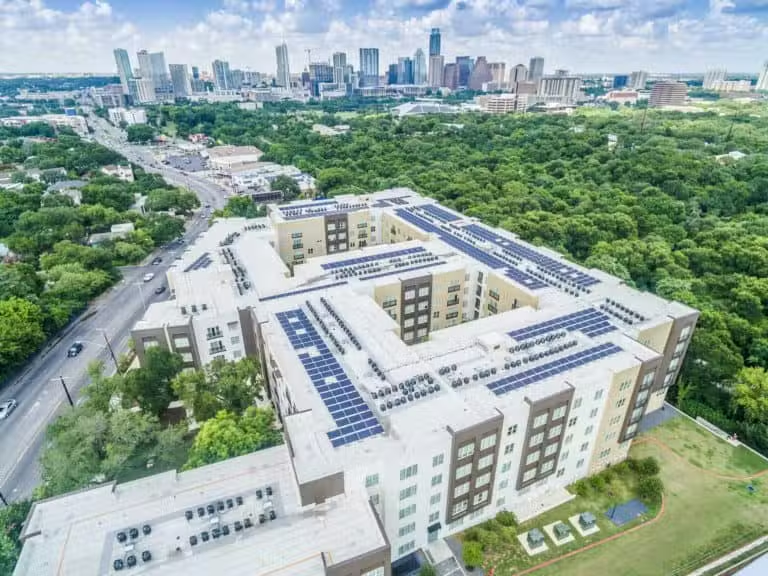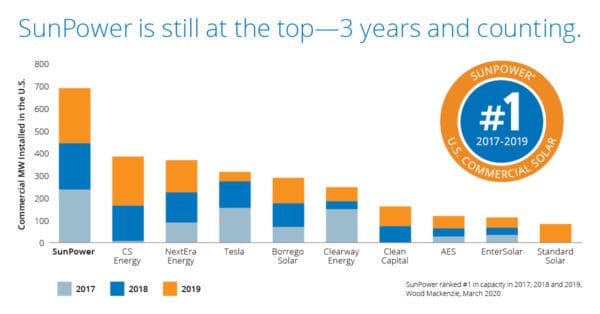COMMERCIAL SOLAR PANEL INSTALLATION AND DESIGN
Utility costs are one of the largest expenses for most businesses. And as your company grows, it consumes more energy — for lighting, HVAC, production, computing, and more.
Compounding the issue, commercial utility rates continue to rise every day. Small and medium-sized businesses (SMBs) in the U.S. already spend more than $60 billion a year on energy. And energy market experts predict that the increases in the average per-kilowatt-hour cost of electricity will persist long-term.

WANT TO KNOW MORE?
Begin a FREE Consultation.
- Send us your info.
- We’ll contact you to schedule an appointment.
- An energy consultant will meet with you at your home, place of business or virtually.
- You will get a custom proposal with system size, design, costs, financing, and savings.
HOW TO CALCULATE PAYBACK AND ROI ON COMMERCIAL SYSTEMS
The payback period refers to the amount of time after your solar panels are installed until they have paid for themselves. The rate at which they pay for themselves depends on their efficiency, as well as your previous electricity costs. Because electricity costs vary by region, your location will also affect your payback period. To calculate the payback period of a solar investment, we simply subtract the annual electricity savings from the upfront cost of the system, net of tax credits and rebates, until we achieve a positive number. Here’s how:
- Identify the upfront cost of the system. Have your solar installer help you figure out the gross cost of your solar panel system.
- Calculate the net of tax credits and rebates. Add all of your financial incentives, including the federal tax credit, state tax credits, rebates, and other offerings, as well as avoided electricity costs.
- Subtract net rebates/credits from up-front costs. Subtract the value of up-front incentives and rebates from the gross cost of your solar panel system
- Determine your overall payback total. Take the number from step 3 and subtract the value of annual electricity savings until you achieve a positive number.
For example, a $300,000 system (less $90,000 for the 30% federal tax credit and $90,000 in depreciation tax savings) that creates $20,000 in annual energy savings will pay back in 6 years.
Most commercial solar projects in Texas have a payback period between 4 and 8 years depending on the location and provide a faster return than residential solar systems.
Keep in mind that the payback period is not necessarily the most important metric for determining the value of a solar investment. The return on investment (ROI) for commercial solar panels should factor in the continued income stream resulting from the solar panels for 40 years or more as well as the increased value of the property should you decide to sell it.
CALCULATING ROI
After you’ve made it through the payback period — which is usually between 5 and 10 years, and received your government solar tax credits, your PV system will have paid for itself, which means you’ll start making a profit. It’s important to know that there are many different factors that affect your solar ROI, but at its simplest, the calculation for your return on investment in solar is:
Lifetime cost of electricity from utility – lifetime cost of solar = solar ROI
- Determine your lifetime cost of electricity from utility. Here’s how to calculate lifetime cost of electricity: Cost of electricity per kWh x monthly kWh usage x 12 months x 25 years.
- Subtract your lifetime cost of solar from step 1, your lifetime cost of electricity. Your lifetime cost of solar will include:
- Equipment
- Shipping
- Permitting & inspection
- Installation
- Incentives & rebates (federal tax credit applies to all above line items)
- Financing fees (if applicable)
- Grid connection fees
- Part replacements
Again, there are many factors that can influence the ROI of your solar system, which is why it helps to have a trusted installer like Design My Solar help you through the calculation process. Here are some top contributors that affect the ROI of your solar investment:
- Installation costs
- Tax incentives
- Fees & permits
- Utility billing structure
- Net metering agreements
CALCULATING INTERNAL RATE OF RETURN (IRR)
The IRR measures the net present value of all cash flows from a particular investment, and companies typically have a minimum IRR threshold for projects. We believe that IRR is a relevant metric to determine whether to invest in a solar PV system instead of other projects during the capital budgeting process or to other investment vehicles more generally.
Texas commercial solar projects often have an IRR above 10% and typically closer to 15%, which tends to be above the minimum acceptable rate of return for many companies. You can use this figure in order to ballpark estimate IRR on your system.
CALCULATING INCREASED PROPERTY VALUE
The capitalization rate measures the value of an asset based on what it produces in terms of income, which is an important component of commercial solar ROI. The income capitalization approach is the preferred method of the National Appraisal Institute to valuate all solar projects, both commercial and residential. Solar is considered a fixture, so the value flows to building itself rather than being measured separately.
So when it comes to property value, how much does a solar installation increase that number? Like our previous calculations, it depends on a few different factors and will vary depending on the setup, location, energy usage, and financial incentives; however, this study will help give you a ballpark range of what to expect: The Lawrence Berkeley National Laboratory produced a calculation of a $5,000 resale value increase for every kilowatt (kW) of solar installed. For example, if your business owns a 9.6kW system, you’d be looking at a $48,000 property value increase (9.6 x $5,000 = $48,000).
CALCULATING COMMERCIAL ENERGY SAVINGS
Your annual energy savings can be calculated by multiplying the above 16 kWh average usage by your utility’s cost of electricity. The national average electricity consumption per square foot for office buildings is 16 kWh per square foot. Here’s how to determine the size of a system that would meet 100% of your electricity usage:
- Multiply your building’s square footage by 16 kWh
- Divide that number by a conservative solar production multiplier of 1,400
To calculate the estimated cost of an average system, multiply the system size in kW by $2.00 per watt. For example, a 50 kW system x $2.00 = $100.00.
OTHER BENEFITS
It makes sense that the direct financial ROI is usually the most important factor in the decision to go solar. Still, there are plenty of other reasons beyond the economic benefits that translate to company growth, including:
- Employee recruiting and retention. Studies have shown that sustainability in the workplace can play a critical role in attracting and retaining high-quality employees. Going solar also shows that a company cares about helping its employees connect specific organizational values to their own personal values.
- Customer attraction and loyalty. When it comes to running your business, customer loyalty is one of the key ways to keep yours successful. Showing your commitment to protecting the environment is a way to improve your relationship with your customers — and keep them coming back.
- Staying competitive. To be a preferred business, you need to constantly be utilizing the newest technology and standing apart from your competition. With the many social and economic benefits it provides, going solar is a responsible and financially wise way to keep up with the rest.
WHY CHOOSE Design My Solar FOR
YOUR COMMERCIAL SOLAR INSTALLATION?

Design My Solar is a leading residential and commercial solar installer and a SunPower partner. Businesses across the United States choose us for our unmatched quality and service — including retail giants Office Depot and Whole Foods! Here are just some of the benefits of working with us:
- Payment plans. We’re passionate about making solar available to everyone, and that means making it as affordable as possible. That’s why we’ll provide you with a personalized quote for your business. We’ll discuss financing and explore every available incentive for saving on your solar panel installation, including net metering, federal rebates, and local incentives.
- Warranties. We’re proud of our products, and our 25-year lifetime warranty for SunPower panels — the most comprehensive in the industry — is proof. This complete coverage warranty on all products gives you peace of mind for the future of your business’s energy needs.
- Battery and backup options. With our options for backup battery systems, you’ll always keep the power on during any outage or emergency.
- Repair and service options. We stand by our commitment to service, and that includes maintenance, repair, and upgrades for any make or model of system we offer.
- Expertise in financial business knowledge. We’re here to guide you through the process to a future of solar energy, and that includes giving expert advice on solar investments. We’ll schedule a free site analysis and proposal that includes financing options that meet your needs, benefitting your business in the long run.
WANT TO KNOW MORE?
Request a Site Analysis.
- Send us your info.
- We’ll contact you to schedule an appointment.
- An energy consultant will meet with you at your home, place of business or virtually.
- You will get a custom proposal with system size, design, costs, financing, and savings.